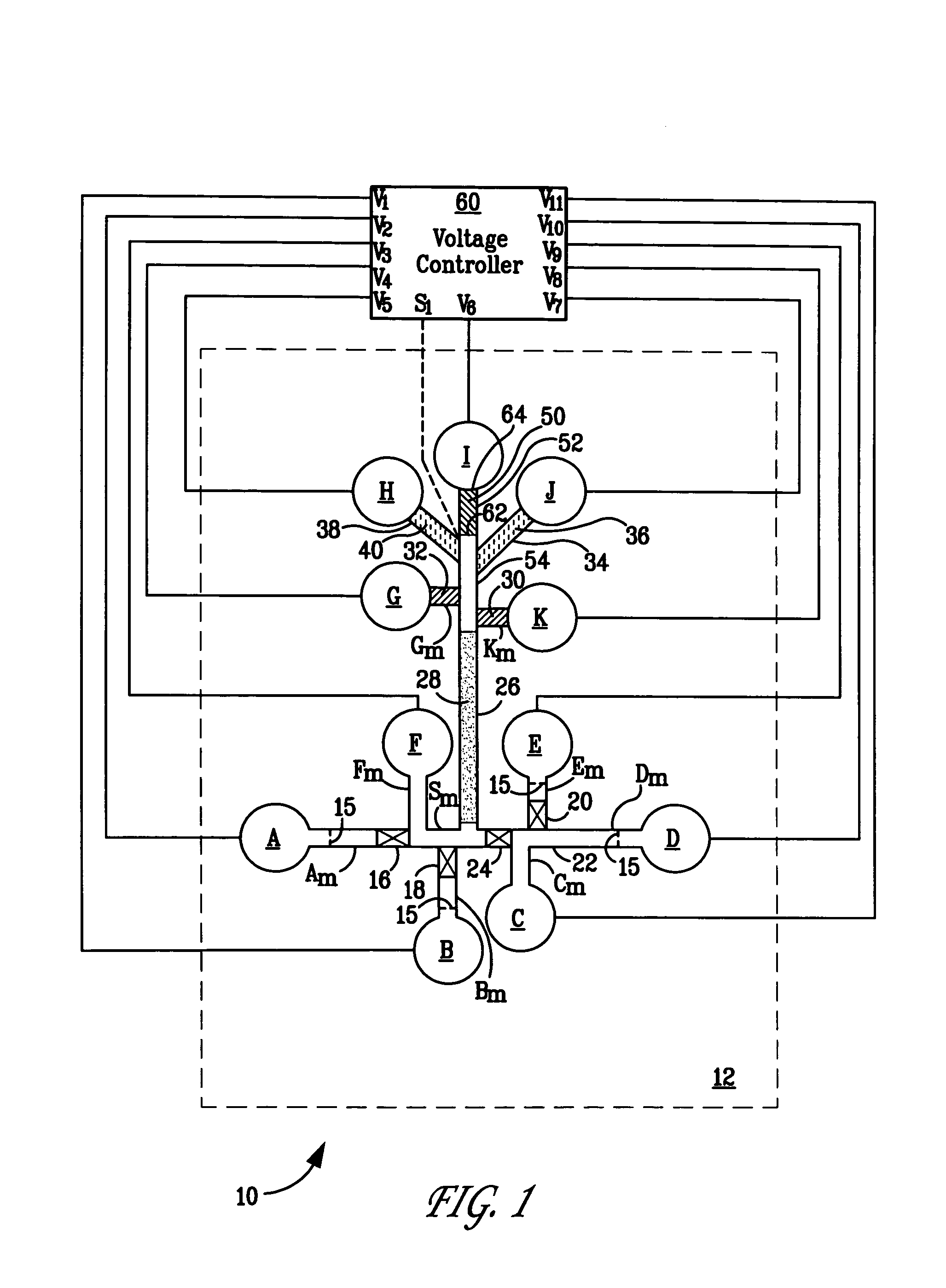Polymeric salt bridges for conducting electric current in microfluidic devices
- Summary
- Abstract
- Description
- Claims
- Application Information
AI Technical Summary
Benefits of technology
Problems solved by technology
Method used
Image
Examples
example 1
[0045]A positively charged salt bridge was prepared by using the following constituents:
[0046]
QTYCONSTITUENTWEIGHT % CONSTITUENT2.437mlTris buffer, (pH 8, 5 mM)50.00.313mlMOE (acrylate monomer),5.080% in water1.325mlHEA (acrylate monomer)26.50.8mlSR-9035 (cross-linker)16.00.125gMBA (cross-linker)2.5
[0047]A first monomer MOE and a second monomer HEA were combined with a first cross-linker SR-9035 and a second cross-linker MBA in a Tris buffer solution at pH 8. Then, 15 ml ammonium persulfate initiator was added and the mixture was injected into a microchannel and polymerized.
[0048]The formulation just described in this Example 1 can be altered to vary the charge concentration as needed by changing the amount of MOE, and adjusting the HEA to achieve a desired monomer / solvent ratio. Conductivity can also be increased by reducing the monomer concentration to as much as 40% of the total volume, which in one embodiment may be accomplished by reducing equal amounts of HEA and SR-9035. Also...
example 2
[0049]A negatively charged salt bridge can be prepared by using the following constituents:
[0050]
QTYCONSTITUENTWEIGHT % CONSTITUENT2.5mlTris buffer, (pH 8, 5 mM)50.00.25gSSS (monomer), 80% in water5.01.325mlHEA (acrylate monomer)26.50.8mlSR-9035 (cross-linker)16.00.125gMBA (cross-linker)2.5
[0051]A first monomer SSS and a second monomer HEA were combined with a first cross-linker SR-9035 and a second cross-linker MBA in an aqueous Tris buffer solution. Then, 15 ml ammonium persulfate initiator was added and the mixture injected into a microchannel and polymerized, preferably by UV cure.
example 3
[0052]A salt bridge was prepared by providing mixture using the following constituents:
[0053]
QTYCONSTITUENTWEIGHT % CONSTITUENT3.0mlTris buffer (pH 8, 5 mM)72.30.15gMBA (cross-linker)3.61.0gSPE (monomer)24.1
[0054]A first monomer SPE and a first crosslinker MBA were provided well mixed in an aqueous Tris buffer solution. Then, 8 ml of ammonium persulfate initiator was added and the mixture injected into a microchannel and polymerized by UV cure. The salt bridge provided by this formulation cures quickly. Also, this formulation is useful in some applications because it does not release any mobile ions into solution, and thus minimizes the impact of the salt bridge on other analytical procedures. However, the large buffer content and low monomer concentration and cross-link density results in provision of a bulk sample that is somewhat fragile in comparison to the salt bridges produced in Examples 1 and 2.
PUM
 Login to View More
Login to View More Abstract
Description
Claims
Application Information
 Login to View More
Login to View More - R&D
- Intellectual Property
- Life Sciences
- Materials
- Tech Scout
- Unparalleled Data Quality
- Higher Quality Content
- 60% Fewer Hallucinations
Browse by: Latest US Patents, China's latest patents, Technical Efficacy Thesaurus, Application Domain, Technology Topic, Popular Technical Reports.
© 2025 PatSnap. All rights reserved.Legal|Privacy policy|Modern Slavery Act Transparency Statement|Sitemap|About US| Contact US: help@patsnap.com



